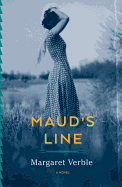
Early in the 20th century, the U.S. government assigned plots of land to American Indians displaced by Oklahoma's statehood. Maud Nail's day-to-day life on her family's allotment is consumed by guns, dirt and chickens. She cares for her men--a dangerous, unruly father, aptly named Mustard, and Lovely, her sensitive, thin-skinned brother--as well as the extended family whose allotments neighbor hers. They recently survived the flood of 1926-27 that covered Oklahoma and much of the Midwest, but the difficulties don't stop there. Margaret Verble's first novel, Maud's Line, details the year in which Maud makes several decisions that will affect the rest of her life.
In her unadorned style, below the violence and hardship on the surface of Maud's life, Verble crafts a story filled with nuance and quiet conflict. She exhibits a talent for characterization: each individual is carefully and distinctly fashioned, so that Lovely's girlfriend and the members of Maud's extended family, for example, shine brightly in even the briefest of appearances. Maud herself is finely wrought, caught between the values she's been raised with--and the people she loves--and a hope for a different life, one with electricity and hygiene in place of dust and blood. One of the greatest strengths of Verble's novel, set on her family's land allotment, is the delicate interior conflicts produced by Maud's deceptively simple life. Propelled by its own momentum, Maud's Line pulls the reader along until, amid daily privations and small tragedies, Maud has the chance for the first time to choose for herself what her future will hold. --Julia Jenkins, librarian and blogger at pagesofjulia

